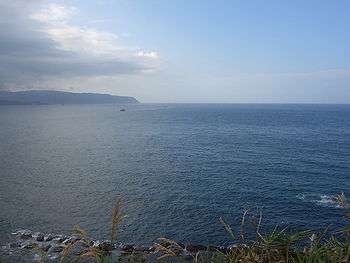East China Sea EEZ disputes
There are disputes between the China, Japan, and South Korea over the extent of their respective exclusive economic zones in the East China Sea.
The dispute between the PRC and Japan concerns the different application of the 1982 UNCLOS, which both nations have ratified.[1] China proposed the application of UNCLOS, considering the natural prolongation of its continental shelf, advocating that the EEZ extends as far as the Okinawa Trough.[2][3] Its Ministry of Foreign Affairs has stated that "the natural prolongation of the continental shelf of China in the East China Sea extends to the Okinawa Trough and beyond 200 nautical miles from the baselines from which the breadth of the territorial sea of China is measured,"[2] which is applicable to the relevant UNCLOS provisions that support China's right to the natural shelf.[2][3] In 2012, China presented a submission under the UNCLOS concerning the outer limits of the continental shelf to the UN.[4][5] Japan, based on UNCLOS, proposed the Median line division of the EEZ.[6]

Under the United Nations' Law of the Sea, the PRC claims the disputed ocean territory as its own Exclusive Economic Zone (EEZ) due to its being part of PRC's natural extension of its continental shelf, while Japan claims the disputed ocean territory as its own EEZ because it is within 200 nautical miles (370 km) from Japan's coast, and proposed a median line as the boundary between the EEZ of China and Japan. About 40,000 square kilometers of EEZ are in dispute. China and Japan both claim 200 nautical miles EEZ rights, but the East China Sea width is only 360 nautical miles. China claims an EEZ extending to the eastern end of the Chinese continental shelf (based on UNCLOS III) which goes deep into the Japanese's claimed EEZ.[7]
In 1995, the People's Republic of China (PRC) discovered an undersea natural gas field in the East China Sea, namely the Chunxiao gas field,[8] which lies within the Chinese EEZ while Japan believes it is connected to other possible reserves beyond the median line.[9] Japan has objected to PRC development of natural gas resources in the East China Sea near an area where the two countries Exclusive Economic Zone (EEZ) claims overlap. The specific development in dispute is the PRC's drilling in the Chunxiao gas field, which is located in undisputed areas on China's side, three or four miles (6 km) west of the median line proposed by Japan. Japan maintains that although the Chunxiao gas field rigs are on the PRC side of a median line that Tokyo regards as the two sides' sea boundary, they may tap into a field that stretches underground into the disputed area.[10] Japan therefore seeks a share in the natural gas resources. The gas fields in the Xihu Sag area in the East China Sea (Canxue, Baoyunting, Chunxiao, Duanqiao, Wuyunting, and Tianwaitian) are estimated to hold proven reserves of 364 BCF of natural gas. Commercial operations began 2006. In June 2008, both sides agreed to jointly develop the Chunxiao gas fields.[10][11]
Rounds of disputes about island ownership in the East China Sea have triggered both official and civilian protests between China and Japan.[12]
The dispute between PRC and South Korea concerns Socotra Rock, a submerged reef on which South Korea has constructed a scientific research station. While neither country claims the rock as territory, the PRC has objected to Korean activities there as a breach of its EEZ rights.[13]
See also
References
- ↑ Koo, Min Gyo (2009). Island Disputes and Maritime Regime Building in East Asia. Springer. pp. 182–183. ISBN 9781441962232.
- 1 2 3 Wang, Yuanyuan (2012). "China to submit outer limits of continental shelf in East China Sea to UN". Xinhua. Archived from the original on December 8, 2013.
- 1 2 Guo, Rongxing (2006). Territorial Disputes and Resource Management: A Global Handbook. New York: Nova Science Publishers, Inc. p. 104. ISBN 9781600214455.
- ↑ "China reports to UN outer limits of continental shelf in East China Sea". Global Times. 2012-12-14. Archived from the original on December 8, 2013.
- ↑ Yu, Runze (2012-12-15). "China reports to UN outer limits of continental shelf in E. China Sea". SINA English. Archived from the original on December 8, 2013.
- ↑ "Diplomatic Bluebook 2006". Ministry of Foreign Affairs of Japan. p. 43.
- ↑ Pike, John. "Senkaku/Diaoyutai Islands". Globalsecurity.org.
- ↑ Kim, Sun Pyo (2004). Maritime Delimitation and Interim Arrangements in North East Asia. The Hague: Martinus Nijhoff Publishers. p. 285. ISBN 9789004136694.
- ↑ Bush, Richard C. (2010). The Perils of Proximity: China-Japan Security Relations. Washington, D.C.: Brookings Institution Press. p. 76. ISBN 9780815704744.
- 1 2 Fackler, Martin (19 June 2008). "China and Japan in Deal Over Contested Gas Fields". The New York Times.
- ↑ Ersan, Yagmur (2013-07-25). "China, Japan conflict on Chunxiao/Shirakaba gas field". The Journal of Turkish Weekly. Archived from the original on December 8, 2013. Retrieved 2013-12-08.
- ↑ "Chinese, Japanese Stage Protests Over East China Sea Islands". Voice of America. 2008-10-15. Archived from the original on December 9, 2013.
- ↑ You, Ki-Jun. "Marine Scientific Research in Northeast Asia". In Nordquist, Myron H.; Moore, John Norton; Soons, Alfred H. A.; et al. The Law of the Sea Conventions: US Accession and Globalization. Martinus Nijhoff Publishers. p. 499. ISBN 978-90-04-20136-1.
- Note, Alexander M. Peterson "Sino-Japanese Cooperation in the East China Sea: A Lasting Arrangement?" 42 Cornell International Law Journal 441 (2009).